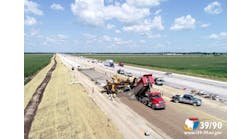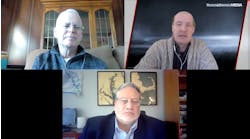The steady growth of our cities and their suburbs has resulted in the paving over of more and more available land. Fields that were once covered with trees and grass are now covered with asphalt or concrete parking lots, driveways, sidewalks, roads and side streets. But as more of our diminishing land area gets paved over, a larger amount of rainwater ends up falling on these now impervious surfaces rather than soaking into the soil.
As a result of this spread of impervious surfaces, more vegetation is deprived of water, the need for irrigation is increased, ground water and water resources are depleted, storm-water runoff increases and the quality of storm-water runoff is degraded.
According to the U.S. Environmental Protection Agency (EPA), storm-water runoff is a leading source of the pollutants entering our waterways. About 90% of surface pollutants are carried by the first 11?2 in. of rainfall. Storm-water drains don’t typically channel this polluted runoff to treatment facilities, but instead carry it directly into local water bodies. This can increase algae content, harm aquatic life and require expensive treatments to make the water potable.
Consequently, the EPA now requires state and local governments to implement measures to reduce and improve the overall quality of storm-water runoff to address this important pollution problem. The EPA Storm Water Phase II Final Rule requires operators of municipal separate storm-sewer systems whose population exceeds 50,000 people to obtain National Pollutant Discharge Elimination System permit coverage because their storm-water discharges are considered “point sources” of pollution.
Absorbing the problem
To address the problems of storm-water runoff, more and more municipalities and commercial developers are switching to pervious concrete—a material that offers the durability and low life-cycle costs of a typical concrete pavement while retaining storm-water runoff and replenishing local watersheds. Pervious concrete pavements also are safer for drivers and pedestrians. Because pervious concrete absorbs water rather than allowing it to puddle, it reduces hydroplaning, tire spray and winter ice buildup.
Pervious concrete is a structural-concrete pavement with a large volume (15 to 35%) of interconnected voids. Like conventional concrete, it’s made from a mixture of cement, coarse aggregates and water. However, it contains little or no sand, which results in a porous open-cell structure that water passes through readily. These factors allow porous pavement to approach natural ground cover in heat absorption and storage capacity. Unlike traditional concrete or asphalt, pervious pavements provide improved filtration and an enormous amount of surface area to catch oils and chemical pollutants. Certain types of porous pavement can pass 3-5 gal of water per minute, which is far greater than most conceivable rain events and highly effective in controlling storm-water drainage.
Pervious concrete, however, is not appropriate for full-scale use on heavily traveled roadways, since its void structure does not have the load-bearing features of traditional concrete. But for low-volume applications, such as parking lots and residential side streets, pervious concrete improves road safety due to prompt drainage of rain and melt water. Using pervious concrete also requires less curbing and storm sewers in the right configuration.
They’re on it
Although pervious concrete is often viewed as a new paving material, it actuality has been used by developers in Florida and throughout the Southern states since the 1970s to control runoff, erosion and flooding. Recently, pervious concrete has been used extensively in states that have freeze-thaw weather. The Michigan Concrete Association is currently in the process of installing pervious concrete in their own parking lot.
In California, pervious concrete has been used to pave parking lots and also is becoming a practical alternative for subdivision streets, sidewalks and golf cart paths. For example, the city of Santa Monica installed pervious concrete gutters on several streets to prevent polluted runoff that would otherwise make its way into Santa Monica Bay. Some parks in California are installing pervious concrete pathways to provide disability access for people in wheelchairs.
When used on subdivision side streets, pervious concrete can reduce road spray and hydroplaning while removing roadway pollution such as oils, greases and other pollutants from the storm-water stream.
Although current demand for pervious concrete is greatest for parking and paving areas, it also has been used for the following:
- A sound-absorption pavement;
- An underlayment to relieve hydrostatic pressure under asphalt or impervious concrete paving; and
- Light-aircraft runways or tarmacs to make use of its ability to prevent puddling and enhance the grip of rubber tires on pavements.
No rest for the bed
Proper installation techniques are crucial for the good performance of pervious concrete pavements. An experienced installer is essential to the success of a pervious project.
Pervious concrete uses a conventional Type I cement, 0.375-in. stone or larger, but with no fines or sand. The mix is produced with a very low water-to-cement ratio, typically 0.3.
The pervious concrete, however, is only part of a pervious paving project. Equal attention must be paid to the recharge bed that is located just below the pervious concrete itself. The recharge bed is required to hold the water that percolates through the pervious concrete and allow it to gradually enter the underlying soil. If the soils on the site have a high clay content and a resulting slow percolation rate, an adequate recharge bed is essential.
Pervious concrete is delivered to the jobsite by conventional ready-mix trucks and placed within standard forms. A vibrating mechanical screed is used to level it off, because pervious concrete is thicker in consistency than regular concrete. Vibration is followed by compaction with a heavy steel roller to attain greater strength.
Pervious concrete typically is installed thicker than regular concrete since water is going to go through it and saturate the subgrade underneath. As a result, a pervious parking lot may be thicker than conventional concrete.
Given pervious concrete’s low water content, proper curing is especially critical. After placement, the concrete should be misted with water and then covered with plastic sheeting and kept damp for at least seven days to allow full hydration of the cement. Spray-on curing compounds, however, should not be used; they are not effective because of the open structure of pervious concrete.
Typically, paving crews can complete pervious concrete jobs faster than when installing regular concrete. These crews typically are larger than a regular concrete paving crew, since many of the installation operations have to be completed at once, including placing, spreading, roller screeding, cross rolling, joint roiling and covering with plastic. Unlike regular concrete, pervious concrete does not require traditional finishing, such as the need to work it with a bull float or trowel, since these finishing operations can seal off the pavement surface and decrease water penetration.
Drain is included
Although initial costs for pervious concrete are higher than conventional concrete or asphalt paving, total costs can be substantially lower. According to the Center for Watershed Protection, installing traditional curbs, gutters, storm-drain inlets, piping and retention basins can cost two to three times more than pervious concrete. Since projects that use pervious concrete typically don’t need storm-sewer tie-ins, there is no need to install underground piping and storm drains. Moreover, it is not necessary to pave an entire area with pervious concrete for it to be effective. As long as it collects runoff from the impervious area, pervious concrete will still be effective in collecting most of the storm water.
Pervious concrete also may reduce the need for municipalities to increase the size of existing storm-sewer systems to accommodate new residential and commercial developments.
Since a pervious concrete pavement doubles as a storm-water management system, developers and property owners do not need to purchase additional land for installing large retention ponds and other water-retention and water-filtering systems. That means developers and property owners can use land more efficiently and maximize the return on their investment.
Pervious concrete is a sustainable paving material, with a life expectancy equal to that of regular concrete. For instance, most pervious parking areas, when properly constructed, will last 20 to 40 years.
With clean water becoming an increasingly scarce commodity, especially in the Western states, the environmental benefits of pervious concrete pavement outweigh the additional cost, especially given its ability to:
- Reduce the amount of untreated runoff discharging into storm sewers;
- Directly recharge groundwater to maintain aquifer levels;
- Channel more water to tree roots and landscaping, so there is less need for irrigation; >li>Mitigate pollutants that can contaminate watersheds and harm sensitive ecosystems; and
- Eliminate hydrocarbon pollution from asphalt pavements and sealers.
In addition to storm-water control, pervious concrete pavements aid in reducing the urban heat-island effect. Because they are light in color and have an open-cell structure, pervious concrete pavements don’t absorb and store heat and then radiate it back into the environment like a typical asphalt surface. The open void structure of the pervious pavement also allows cooler earth temperatures from below to cool the pavement.
Beyond helping the environment, pervious concrete pavements also are safer for drivers and pedestrians. Because pervious concrete absorbs water rather than allowing it to puddle, it reduces hydroplaning, tire spray and ice buildup. As municipalities continue to look at the costs of handling storm-water runoff, even to the point of adding fees to the use of impervious pavements, pervious concrete will be increasingly regarded as an economically and environmentally sound solution to a persistent problem.


